Report
Management system of CO2 and H2O flux measurement in Kiryu (Japan), KogMa and MaeMo (Thailand) experimental forest
Rina Yamamura ![]()
International Environmental and Agricultural Science (IEAS)
Graduate School of Agriculture
Host Organization: Faculty of Forestry, Kasetsart University in Thailand, Tokyo university, and Kyoto university
Location: Japan and Thailand
Duration: 2013.05.27~05.29 (Kyoto)
08.06~08.19 (Thailand)
Key words: forest, CO2 uptake, internationally collaborated management system, multi-disciplinary measurement system
1. Activities during the internship
During this internship, I had the opportunity to be a member of a research group that consists of Tokyo University, Kyoto University, Mie University in Japan and Kasetsart University in Thailand. They have been conducting leading investigation on water and carbon cycling and ecological system of forest in Kiryu (Japan), KogMa, MaeMo (Thailand) and so on.
First, I visited the Kiryu site from May 27 to 29 and learned a long term management system of the EC (eddy covariance) method (Fig. 1. (A), (B) and (C)). The EC method is one of the standard methods for examining the flux in relatively large areas (few hundreds to millions of square meters). The site was established in 1967 and the EC method has been conducted for 14 years (since 1999) in Japanese
cypress and cedar forest by Dr. Kosugi of Kyoto University. It is one of the sites where measurement has been conducted for the longest period in Japan. Indeed, in my master program, I have been working on the evaluation of CO2 and H2O
fluxes of steep Japanese cypress forest by using the EC method. Therefore, it was a very precious opportunity for me.
Second, I visited Thailand sites, KogMa and MaeMo. In these two ever green forests
sites, Multi-disciplinary researches have been conducted such as monitoring of flux and tree physiology. These researches have been under the international collaboration by Japanese researchers group and Kasetsart University. It is the only university that has faculty of forestry in Thailand. Followings are local collaborators, Dr. Chatchai who is a counterpart at Kasetsart University, Ms. Ei who keeps the experimental forest and students lodging of KogMa and also arranges an extra driver, Mr. Swang who was a FIO (Forest Industry Organization) worker at MaeMo but now engages in collection of data requested by Japanese researchers such
as rainfall and leaves data in MaeMo with his son, and Mr. Ming who is a driver. Japanese researchers employ Mr. Swang, his son and Mr. Ming.
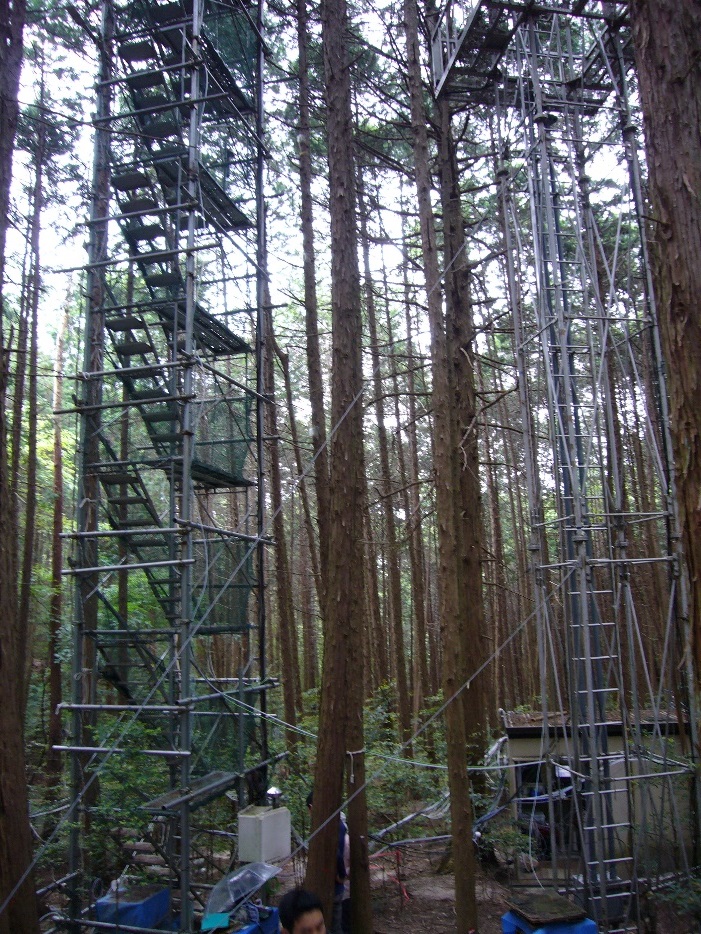 |
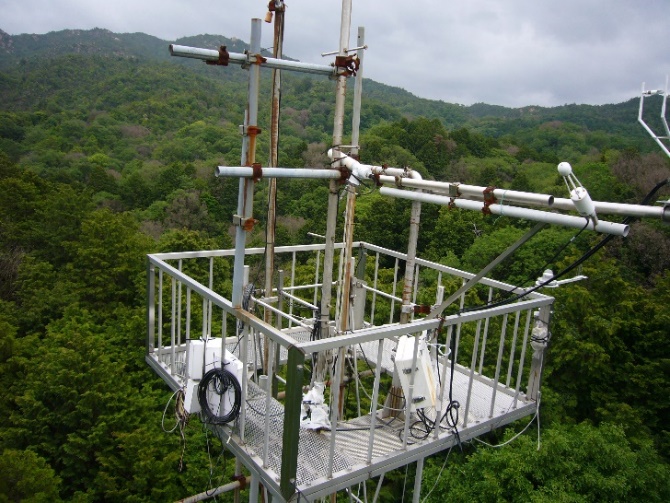 |
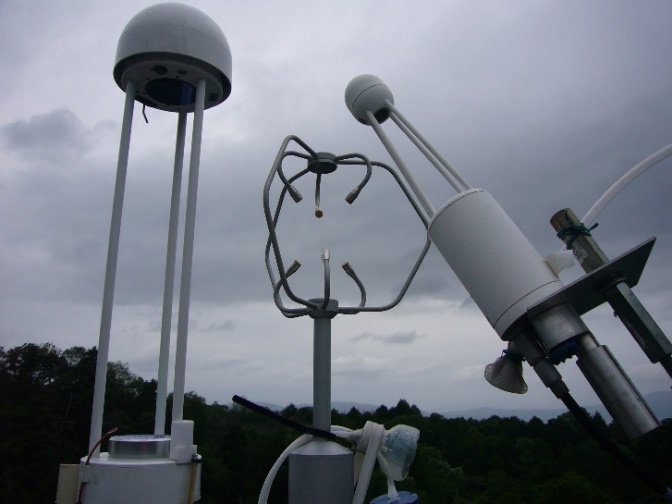 |
|
Fig.1(A)Two towers in Kiryu. Left one is newer |
Fig.1(B)Top of the right tower; |
Fig.1(C)EC instruments of the left tower
|
|
KogMa site is an experimental forest of Kasetsart university and located next to a national park in Chiangmai (18 ° 48 N, 99 ° 54E, 1265–1420 m above sea level). Typical species are Cinnamomum porrectum, Lithocarpus elegans, Castanopusis acuminatissima and Schima wallichii. A 50m flux measurement tower was built by Japanese researchers in 1996, and observation started in 1998. I visited KogMa site from August 7 to 8. There, I assisted Dr. N. Tanaka of Tokyo University studying fog on the tower and Ms. Ei with safety checking of the tower. Specifically, the tower was a little distorted because safety wires of the tower got pressure from some liana (Fig. 2. (A)). Besides, two fallen trees lied in a road to the tower (Fig. 2. (B)). To check on the damage, Dr. Tanaka led Ms. Ei to all problematic wires and discussed the way of removal.
On the other hand, MaeMo site is a teak plantation (Tectona grandis Linn. f.) established in 1968, in Lampang province, northern Thailand (18 ° 25 N, 99 ° 43E, 380 m above sea level, Fig. 2. (C)) managed by FIO MaeMo branch office (Fig. 2. (D). Teakwood has high market value and thus teak plantations have been widely established throughout the tropics in Indochina and India (Krishnapillay, 2000). Until the 1960 - 70s, drastic decreases in forested area had occurred in SE Asia. Recently, however, forest rehabilitation and plantations have been increasingly promoted in the region (Igarashi et al., in press). In recent 4 or 5 years, FIO exported timbers to Singapore and India. As described above, Kasetsart University is the only university that has faculty of forestry, so all of the chiefs and sub chiefs of FIO are graduates of the university. Therefore, it was relatively easy to get permissions for cutting trees and so on for our researches in the forest through Dr. Chatchai. Indeed, in 2013 March, 35×50 m plot was thinned by FIO. The site has an area of 2000 ha, and the 55 m EC measurement tower was located in central part of the area.
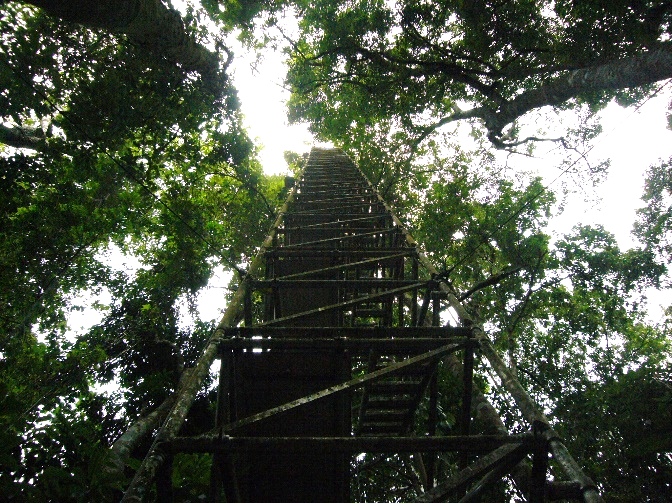 |
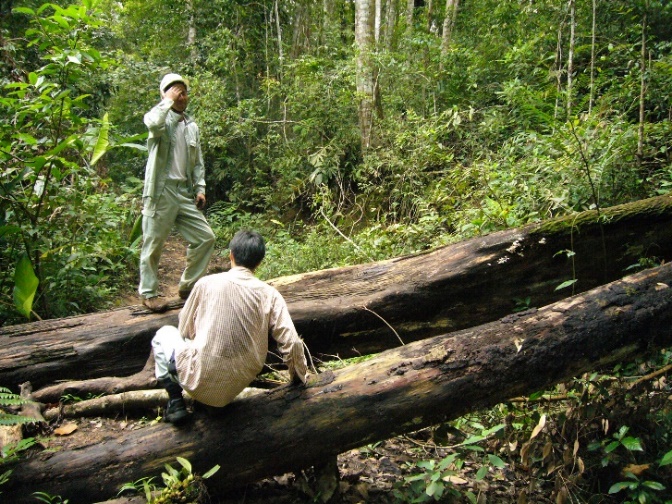 |
Fig.2(A) A distorted tower in KogMa; |
Fig.2(B) Two fallen trees lied in a road; |
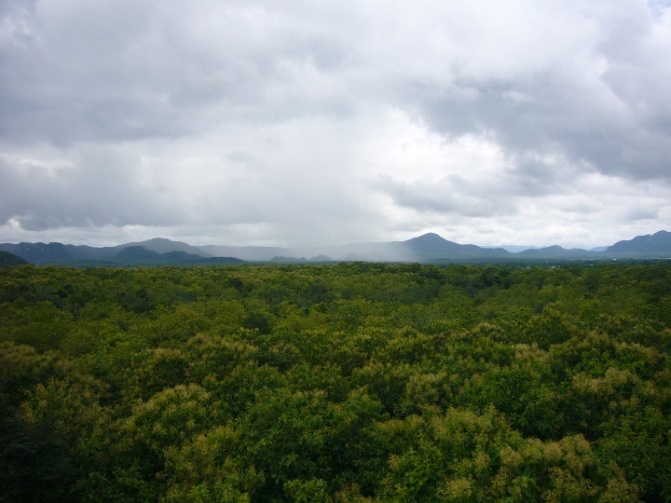 |
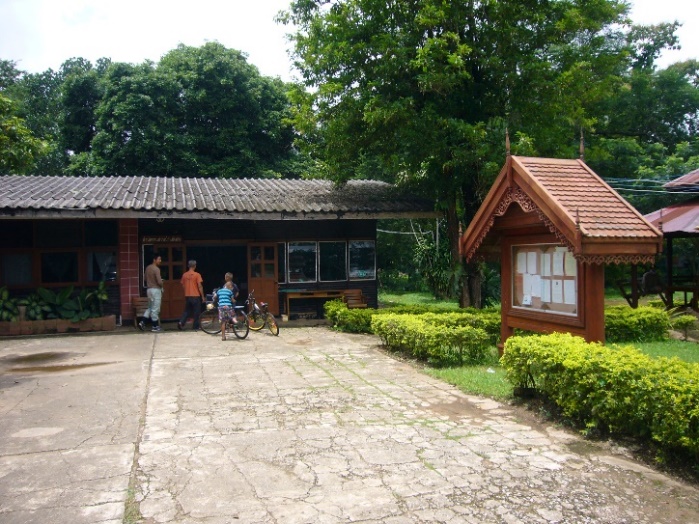 |
Fig.2(C)MaeMo plantation; |
Fig.2(D)FIO office in MaeMo |
I stayed in MaeMo for 9 days from August 9 to 18. There, 7 multi-disciplinary researches are conducted by Japanese researchers group. I describe only one keyword for each of them: EC measurement, soil respiration, sap flow, intercepted rainfall, leaf physiology, water potential of sap, and water-sprinkled tree physiology.
In MaeMo, first, I assisted maintenance of some EC method’s instruments on the tower and learned the measurement system of that. Second, I assisted the measurement of soil respiration which had been conducted since 2000. During this internship, we measured 53 points soil respiration (Fig. 3. (A)) and the data will be used for evaluation of long-term trend and the influence of thinning. Third, on the night of 13th, we had a dinner with a chief and a sub chief of FIO MaeMo branch office. I interviewed them about their work for Japanese researchers and their feelings about that. As I described, when Japanese researchers ask a chief of FIO MaeMo branch office for some work, he orders his workers to do that if there is no problem to their timber production. They do not have hard feeling about that because they trust Dr. Chatchai. I felt there is a strong connection between Dr. Chatchai and FIO. And Japanese researchers have collaborated for 17 years. These two connections are at the core of this international research collaboration. Finally, I was present in the meeting about requests from Dr. Tanaka to local workers, Mr. Swang and Mr. Ei. Before that, Dr. Tanaka wrote up all requests from researchers to them in one page requests sheet. And he demonstrated how to do requested jobs according to the sheets (Fig. 3. (B)). Next day, he checked whether they can definitely do their jobs or not.
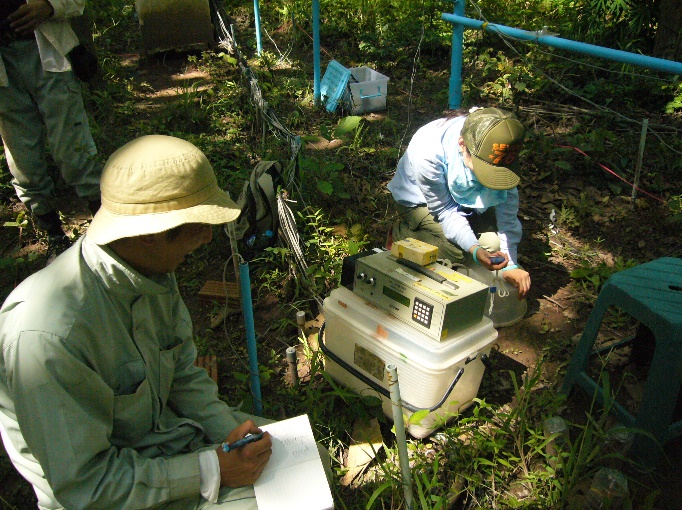 |
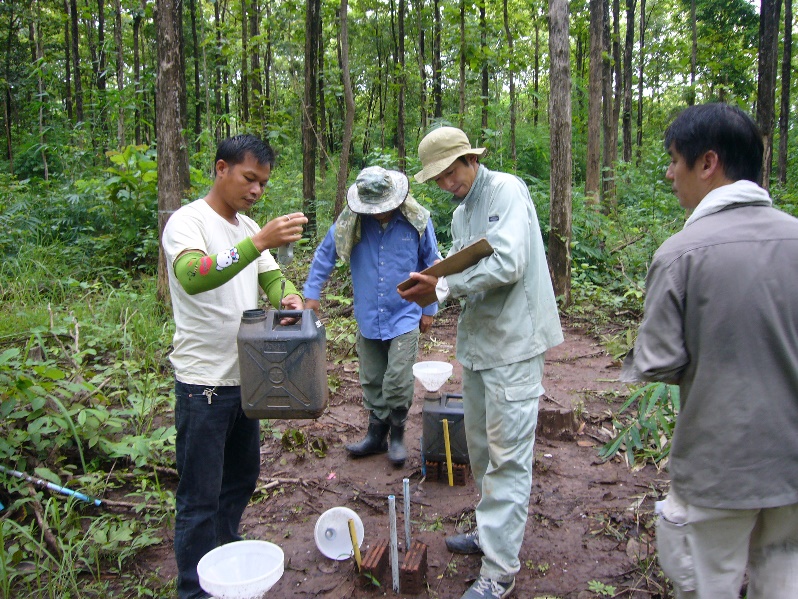 |
Fig. 3. (A) Measurement of soil respiration by Dr. Tanaka and me; |
Fig3.(B) Demonstration of requested data collecting |
2. Experience and achievements resulting from the internship
As a result of this internship experience I expanded my scientific and practical knowledge for research. It was particularly meaningful for me to have experienced following three management systems, (1) a domestic long-term observation management system in Kiryu, (2) an internationally collaborated management system in Thailand, and (3) a multi-disciplinary measurement system in Thailand. All of them are necessary for not only CO2 and H2O fluxes measurement using EC method but also any scientific research.
1) Kiryu site: Long term measurement management system
In Kiryu, a roster system is conducted by the students for long term observations to collect data such as meteorological and hydorological data. On the other hand, some progressive approaches are introduced in the site such as CH4 flux and profile monitoring using TDLS (Tunable Diode Laser Spectroscopy). Hence, I think it is important for a long term observation project not only to keep regular measurements, but also to add new observations that answers the new needs, for leading to significant results.
2) KogMa and MaeMo site: internationally collaborated multi-disciplinary measurement system
As a matter of course, we cannot go to a foreign research site very often. So it is essential to conduct successful research in foreign site with help by local workers. I realized that when Dr. Tanaka ask something to local workers, he thinks about workers’ feelings. In fact, he changed the measurement method of daily rainfall data to make local workers’ work load lighter. Before that, they measured the quantity of stored rainfall by commonly used graduated cylinder. However, he changed from cylinder to spring balance, which get workers to measure it easier and faster. By doing that, he upkeeps the relationship with them, improves their motivation and make it easy for them to continue their works.
Commencing with Dr. Chatchai, there are many collaborators including local workers in Thailand. However, it is a problem that there is no local student researching in KogMa or MaeMO with Japanese.
Dr. Chatchai said Thai students tend to want studying typical advanced technologies like remote sensing. And they do not want to feel like doing field research. I think environmental education in Thailand is not enough. When I was a first year student of TUAT, I didn’t feel like walking in forest for my research. However, through the classes, I learned that the tropical rain forests contribute major latent energy sources, changes and reduction of tropical forest affect carbon and water balance in tropical and adjacent regions. And I feel the necessity and importance of field researches for improving the CO2 absorption ability of forests.
Therefore, I suppose the lectures or field observation classes that help students to arrive at the awareness of the field work’s importance for solving immediate global environmental problem such as climate change and deforestation should be taken place in Thailand too.
3.Relationship between the internship experience and future career development as a field-oriented leader in Asia and Africa
I gained valuable knowledge, skills and experience that will help me to become a leader in the environmental sector. In particular, Thailand study sites are managed by both local counterparts (Kasetsart Univ.) and Japanese groups (Kyoto, Kyushu, Nagoya, and Tokyo Univ.). Each of the groups is working on different topics including eddy covariance systems. Therefore, not only international collaboration but also multi-disciplinary corroboration is important. Indeed, when eddy covariance is examined, the other data sets such as soil moisture, vegetation species types, and tree physiology are also important as ecosystem processes. Therefore, various monitoring topics should be arranged and organized by the research group under multidisciplinary collaboration.
Secondary, continuous monitoring of flux is important. However, continuous monitoring is typically difficult because of the limitation of financial support and labors. Therefore, it is crucial to know how the monitoring effort is technically continued. Such experiences can be useful when I will be involved in forest environmental issues with local people.
Lastly, I would like to thank my hosts, Dr. Kosugi, Dr. Tanaka and all of the researchers I worked with in tree sites. I would also like to thank FOLENS and Professor Takashi Gomi for enabling me to participate in this internship, which was a very valuable experience for me.